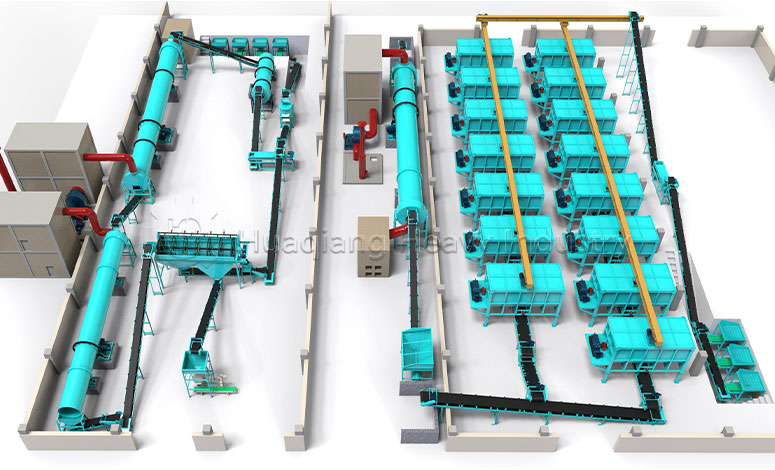Biofertilizer Fermentation: Precision Microbial Cultivation
The fermentation process of biofertilizers is a highly controlled technical procedure, with the core objective of achieving large-scale propagation of functional microorganisms and their stable colonization on carriers. The entire process consists of two key stages: liquid strain fermentation and solid carrier fermentation.
Liquid Strain Fermentation: From Laboratory to Industry
Liquid fermentation employs a three-stage amplification system, starting from laboratory-scale flask cultivation and gradually scaling up to industrial-level large fermenters. Throughout this process, temperature, pH, and oxygen supply require precise control to ensure rapid reproduction and high activity maintenance of functional strains. The ultimate goal is to obtain highly active bacterial solutions with counts exceeding 10 billion per milliliter.
Solid Carrier Fermentation: Stable Microbial Colonization
After obtaining highly active bacterial solutions, they need to be uniformly adsorbed onto organic carriers. Carriers require rigorous pretreatment, including crushing, sterilization, and parameter adjustment. The adsorption process is completed in double-screw mixers, followed by 3-7 days of static fermentation to allow strains to form stable biofilms on carrier surfaces.
Organic Fertilizer Production: Natural Maturation Transformation
The core of organic fertilizer production lies in aerobic fermentation maturation, relying on natural microbial communities present in raw materials to convert organic waste into stable humus. This process emphasizes organic matter decomposition and harmless treatment.
Industrial Production Process
Industrial production utilizes trough-type turning aerobic fermentation technology, completing organic matter maturation transformation within 15-30 days through precise control of carbon-to-nitrogen ratio, moisture, and ventilation conditions. The high-temperature phase maintains 55-65°C for 3-5 consecutive days, effectively eliminating pathogenic bacteria and insect eggs to ensure product safety.
Household Simple Production
Households and small farms can adopt simple composting methods, ensuring oxygen supply through regular turning, completing the fermentation process within 15-45 days. Although this method has lower efficiency, it offers low costs and suits small-scale applications.
Core Process Differences
Fundamental Differences in Temperature Control
Biofertilizer fermentation maintains temperatures below 35°C throughout to protect functional strain activity, while organic fertilizer production requires 55-65°C high temperatures to achieve harmless treatment. This temperature difference reflects the completely different objective orientations of the two processes.
Differences in Microbial Sources
Biofertilizers use artificially inoculated specific functional strains, such as nitrogen-fixing bacteria and phosphorus-solubilizing bacteria, while organic fertilizers rely on natural microbial communities present in raw materials. This difference determines the different focuses in product quality control.
Core Value of Final Products
The value of biofertilizers mainly manifests in effective viable bacteria count and their functional activity, while the value of organic fertilizers lies in organic matter content and maturation degree. This difference gives the two fertilizers distinct application values in agricultural production.
Understanding the fundamental differences in fermentation processes between biofertilizers and organic fertilizers helps producers choose appropriate technical routes and assists users in selecting suitable fertilizer products based on specific needs. These two types of fertilizers each have unique characteristics and play irreplaceable roles in modern sustainable agriculture.
Integrating Fermentation Technologies into Modern Fertilizer Production Lines
The distinct fermentation processes for biofertilizers and organic fertilizers require specialized equipment and production approaches. Modern bio organic fertilizer production line configurations must accommodate both the precise temperature control needed for microbial cultivation and the high-temperature phases required for organic fertilizer fermentation. Key equipment like the chain compost turner and large wheel compost turning machine maintain optimal aerobic conditions during the organic matter decomposition phase, while specialized bioreactors handle the sensitive microbial propagation stages.
Following fermentation, complete organic fertilizer production line systems utilize various granulation technologies. The rotary drum granulator and drum granulator excel in drum granulation of organic materials, while the double roller press granulator and fertilizer roller press machine provide alternative compaction methods. These fertilizer granulator options allow producers to create products with specific physical characteristics suited to different application methods and crop requirements.
Meanwhile, npk fertilizer production line operations follow a completely different npk manufacturing process, utilizing chemical granulation through specialized npk fertilizer granulator equipment. The npk production process focuses on precise nutrient ratio control rather than microbial activity. As fertilizer technology evolves, the integration of these different production approaches enables manufacturers to create comprehensive product portfolios that address both soil health and crop nutrition needs in modern agriculture.
